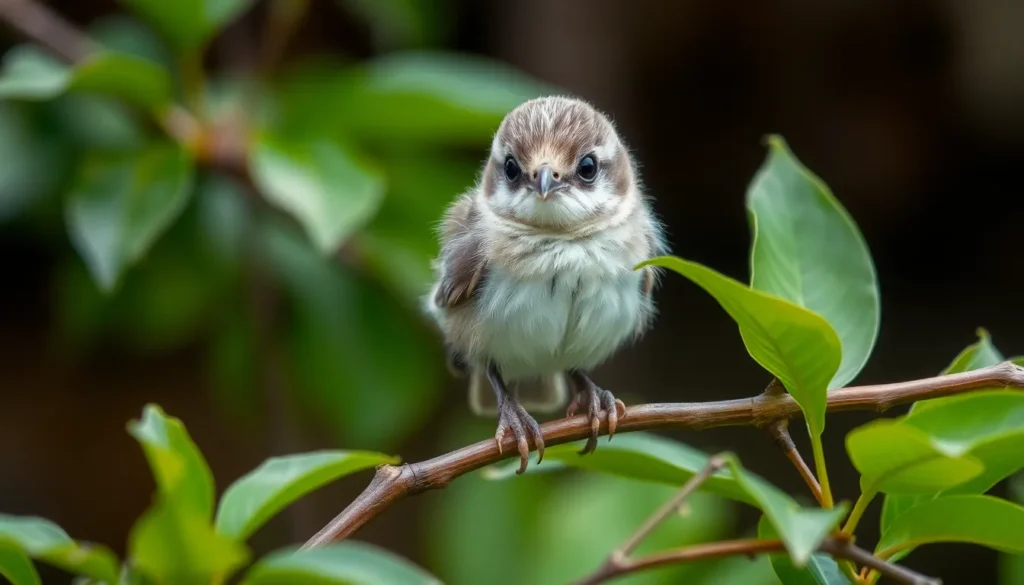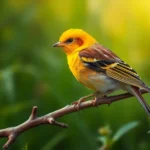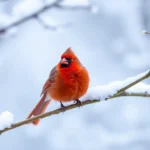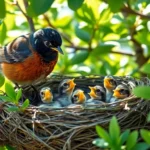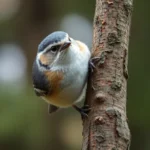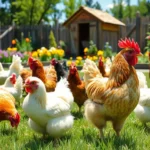When we stumble upon a tiny, helpless baby bird that’s fallen from its nest, our first instinct is often to rescue it. But what seems like an act of kindness might actually do more harm than good. These delicate creatures have exact needs that differ dramatically from adult birds, and understanding their behavior can mean the difference between life and death.
We’ve all been there – walking through our backyard or local park when we spot a small, seemingly abandoned chick chirping frantically on the ground. Our hearts immediately go out to these vulnerable babies, but the reality is that many “abandoned” birds aren’t actually in distress at all. They’re simply learning to fly or being cared for by parents we can’t see.
Before we intervene, we need to understand what we’re really looking at. Baby birds go through distinct developmental stages, and each requires different care approaches. Let’s explore the intriguing area of these tiny creatures and learn when to help – and when to step back.
What Is a Baby Bird?
A baby bird represents any young avian species that hasn’t yet reached full maturity or independence from parental care. We encounter these developing creatures at various stages of growth, each requiring different levels of intervention or observation.
Physical Characteristics of Baby Birds
Baby birds display distinct physical features that change dramatically as they mature. Newly hatched chicks typically have closed eyes, minimal or no feathers, and pink or dark skin that appears translucent. Their heads seem disproportionately large compared to their bodies, and they lack the ability to regulate their own body temperature.
Feather development occurs in exact patterns across different species. Down feathers emerge first, providing basic insulation and giving young birds a fluffy appearance. Pin feathers then break through the skin as small, pointed structures that eventually unfurl into full flight feathers. The beak remains soft and flexible during early development, gradually hardening as the bird approaches independence.
Size variations depend entirely on the species. Hummingbird babies measure less than an inch at hatching, while raptor chicks like hawks or eagles can reach several inches in length. Coloration often differs from adult plumage, with many baby birds sporting muted browns, grays, or spotted patterns that provide natural camouflage.
Developmental Stages From Hatchling to Fledgling
We recognize three primary developmental phases in baby bird growth. The hatchling stage begins immediately after the chick breaks free from its egg and lasts approximately 3 to 14 days depending on species. During this period, baby birds remain completely dependent on their parents for warmth, food, and protection within the nest.
Nestlings represent the second developmental phase, characterized by rapid feather growth and increased mobility within the nest. Eyes open during this stage, typically between days 5 to 10 after hatching. Nestlings begin developing their distinctive calls and start exercising their wings in preparation for flight. This phase continues for 1 to 4 weeks depending on the species.
Fledglings mark the final pre-adult stage when young birds first leave the nest but still receive parental care. These birds possess most of their flight feathers but lack the coordination and strength of fully mature adults. Fledglings spend 1 to 6 weeks learning essential survival skills like foraging, predator avoidance, and proper flight techniques. Parents continue feeding and protecting fledglings during this critical learning period, even though the young birds may appear abandoned to human observers.
Common Types of Baby Birds You Might Encounter
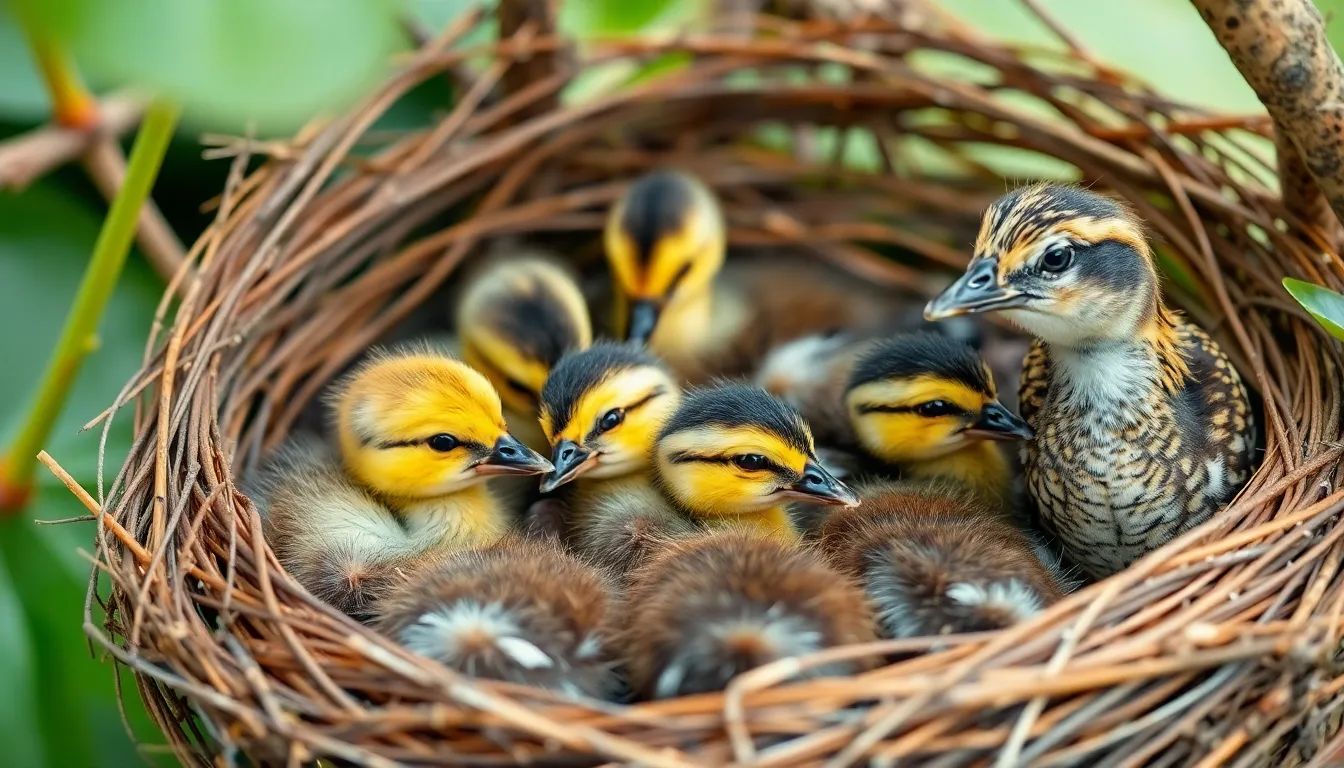
We encounter different species of baby birds throughout various seasons and habitats. Each type displays unique characteristics and developmental patterns that help us identify them correctly.
Songbird Babies
Songbird babies represent the most frequently found young birds in residential areas and parks. Cardinals, robins, sparrows, and finches produce altricial young that hatch with closed eyes and minimal downy feathers. These nestlings remain in their nests for 9-16 days depending on the species.
Robin chicks develop their characteristic spotted breast feathers around day 8, while cardinal babies show bright orange beaks that gradually fade to adult coloration. House sparrow nestlings display pale yellow gape flanges at the corners of their beaks. Finch babies often appear smaller than other songbird young, weighing only 1-2 grams at hatching.
Fledgling songbirds leave their nests before achieving full flight capabilities. We observe them hopping on the ground or perching on low branches while their parents continue feeding them. Their tail feathers appear shorter than adult proportions, and their wing feathers show incomplete development for the first 7-10 days after fledging.
Waterfowl Young
Waterfowl young exhibit precocial development, meaning they hatch with open eyes and downy feathers covering their bodies. Ducklings, goslings, and cygnets leave their nests within 24-48 hours after hatching to follow their mothers to water sources.
Mallard ducklings display yellow and brown striped down patterns that provide excellent camouflage among reeds and vegetation. Canada goose goslings show gray and yellow down with distinctive dark eye stripes. Swan cygnets appear grayish white and measure significantly larger than other waterfowl babies at 4-6 inches in length.
These young birds swim and dive independently from their first day but rely on their mothers for protection and guidance to food sources. Waterfowl babies cannot regulate their body temperature effectively for the first week, requiring frequent brooding under their mother’s feathers. We often observe them forming tight family groups while foraging in shallow water areas.
Birds of Prey Chicks
Birds of prey chicks develop as semi-altricial young, hatching with some down covering but requiring extended parental care. Hawk, eagle, and owl babies remain in their nests for 4-12 weeks depending on species size and hunting requirements.
Red-tailed hawk nestlings display white downy feathers with dark wing and tail markings beginning to emerge around week 3. Great horned owl chicks show distinctive ear tufts developing at 2-3 weeks old, along with their characteristic large yellow eyes. Bald eagle young appear significantly larger than other raptor babies, reaching 12-14 inches in height before fledging.
Raptor chicks possess sharp talons from hatching and demonstrate aggressive begging behaviors when parents approach with food. Their diet consists entirely of prey brought by adults, including rodents, fish, and smaller birds. We notice these young birds practicing hunting motions and wing exercises while still in their nests, preparing for their eventual independence at 8-20 weeks of age.
How to Identify If a Baby Bird Needs Help
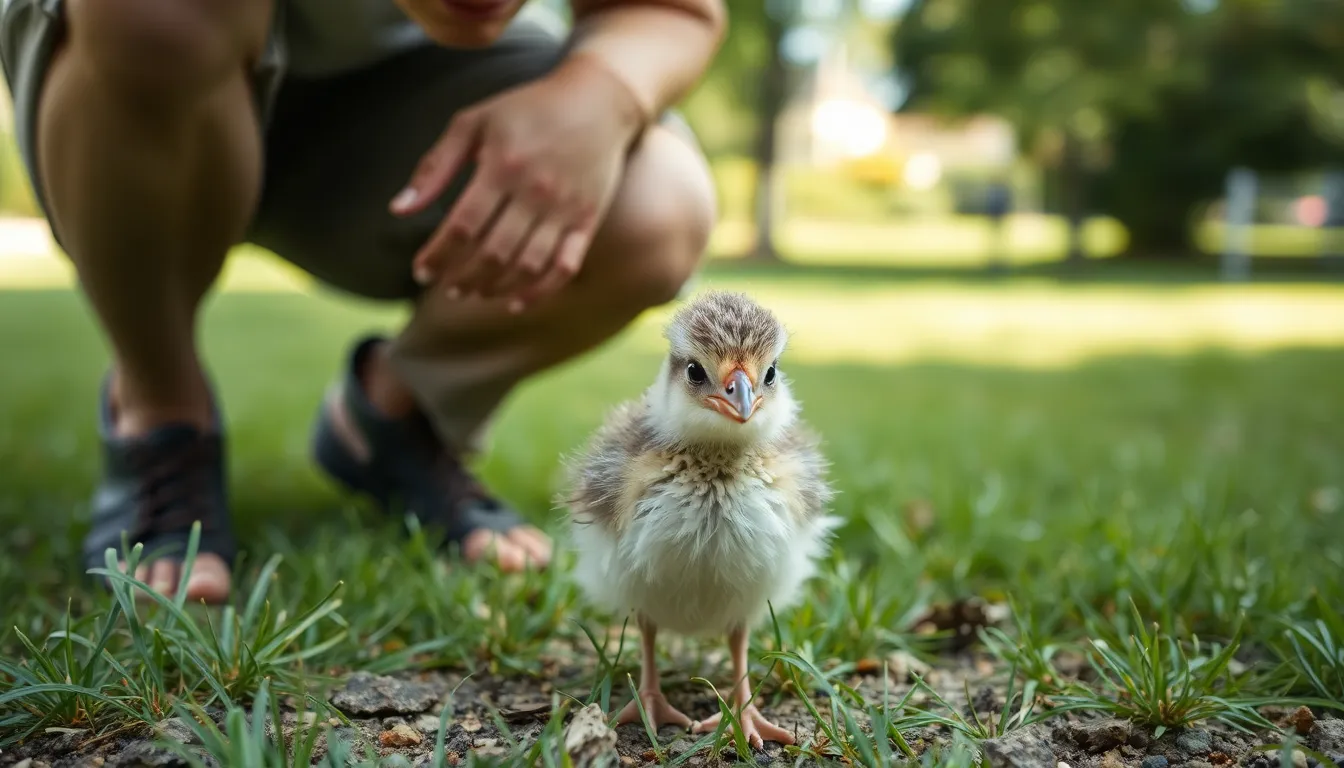
Determining whether a baby bird requires human intervention involves careful observation of exact behavioral and physical indicators. We can distinguish between natural developmental processes and genuine distress situations by recognizing key signs that indicate the bird’s current state of wellbeing.
Signs of a Healthy Baby Bird
Healthy baby birds exhibit distinct behaviors and physical characteristics that indicate proper development and parental care. We observe these positive indicators when young birds are thriving in their natural environment.
Active Movement and Alertness
- Responsive head movements when approached or touched
- Alert eyes that track movement and react to stimuli
- Coordinated wing fluttering during feeding attempts
- Steady breathing patterns without gasping or labored respirations
Proper Physical Development
- Clean, well-groomed feathers without excessive debris or parasites
- Bright, clear eyes without discharge or cloudiness
- Pink or appropriate colored mouth interior during vocalizations
- Proportionate body weight relative to species and developmental stage
Normal Vocalizations
- Regular chirping or calling sounds appropriate for species
- Increased vocal activity when parent birds approach
- Begging calls that demonstrate hunger and energy
- Communication sounds that indicate social awareness
Evidence of Parental Care
- Fresh droppings around the nest area indicating recent feeding
- Parent birds observed in the vicinity within 2-3 hours
- Clean nest environment maintained by adult supervision
- Appropriate nesting material and structural integrity
Warning Signs That Indicate Distress
Distressed baby birds display exact symptoms that require immediate attention and potential intervention. We identify these concerning indicators through systematic observation of behavioral changes and physical abnormalities.
Physical Injury Indicators
- Visible wounds, cuts, or bleeding on wings, body, or legs
- Drooping or twisted wings that cannot fold properly against the body
- Limping, inability to grip surfaces, or leg injuries
- Swollen areas, unusual lumps, or deformed body parts
Behavioral Distress Signals
- Listlessness or lack of response to stimuli after several hours
- Continuous weak crying without normal periods of rest
- Inability to hold head upright or maintain balance
- Repeatedly falling over or struggling to right itself
Environmental Danger Signs
- Presence of cats, dogs, or other predators in immediate vicinity
- Exposure to harsh weather conditions for extended periods
- Location in dangerous areas like roads, parking lots, or construction zones
- Nest destruction or complete absence of nesting structure
- Difficulty breathing, gasping, or open-mouth breathing
- Eyes that remain closed during daylight hours in older nestlings
- Discharge from eyes, beak, or nostrils
- Lack of parental attention for more than 4-6 hours during daylight
- Hypothermia indicated by cold body temperature and shivering
| Observation Timeline | Action Required | Species Consideration |
|---|---|---|
| 1-2 hours | Monitor from distance | All species |
| 2-4 hours | Check for parent activity | Songbirds, waterfowl |
| 4-6 hours | Assess intervention needs | Cavity nesters, raptors |
| 6+ hours | Contact wildlife rehabilitation | All species |
What to Do If You Find a Baby Bird
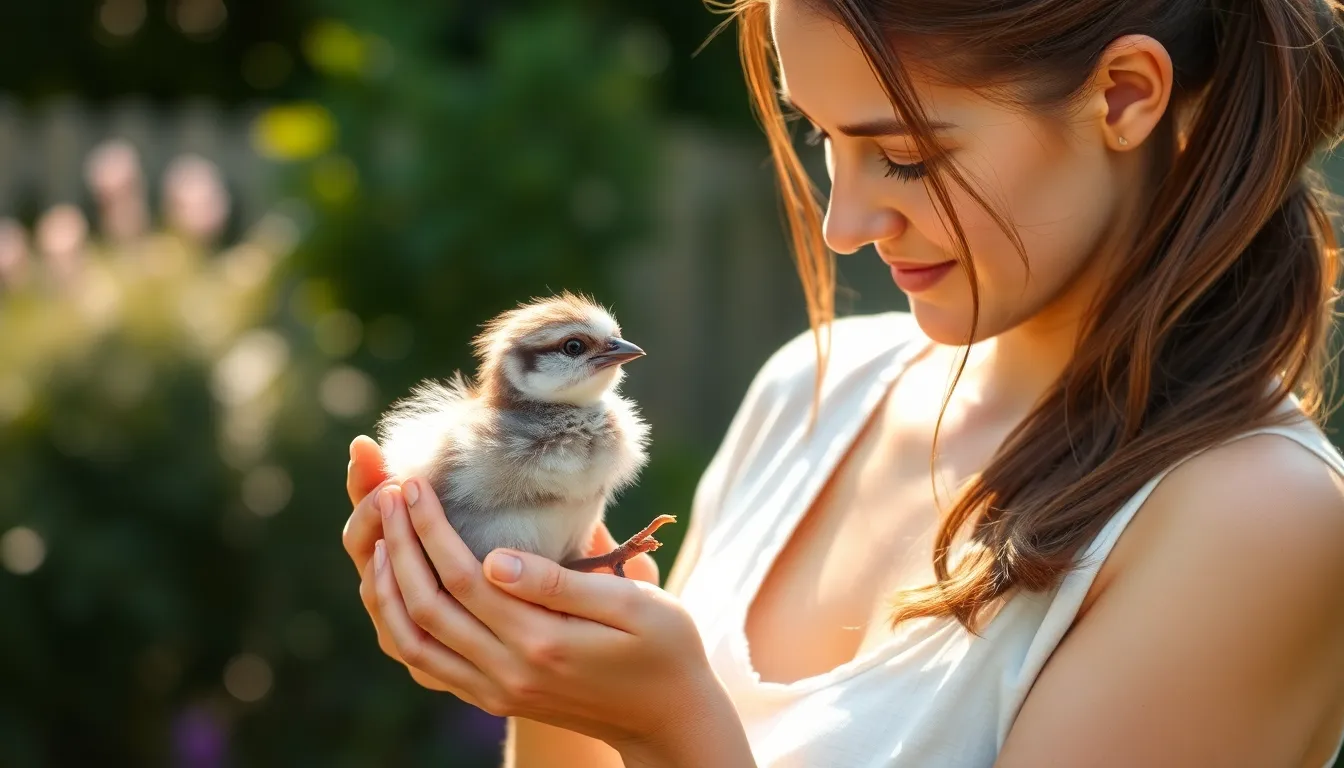
Finding a baby bird triggers our natural desire to help, but the correct response depends entirely on the exact situation and the bird’s actual condition. We must evaluate each encounter carefully before taking any action.
When to Leave the Bird Alone
Fledglings that appear healthy but remain on the ground often receive continued parental care even though being outside their nest. We observe these young birds hopping along the ground or perching on low branches as part of their natural learning process. Parents typically stay within a 100-yard radius and return every 20-30 minutes to feed their offspring.
Situations requiring no intervention include:
- Alert fledglings with fully opened eyes that can stand upright
- Baby birds showing active movement and vocalizing normally
- Young birds found in areas with dense vegetation or natural cover
- Nestlings discovered in intact nests positioned securely in trees or shrubs
- Waterfowl babies following their mother in appropriate aquatic environments
We wait at least 2 hours while observing from a distance of 50+ feet before determining if parents have truly abandoned their young. Adult birds often avoid their offspring when humans remain nearby, creating false impressions of abandonment.
Safe Handling and Transportation Methods
Baby birds require gentle handling techniques that minimize stress and prevent additional injuries when intervention becomes necessary. We approach slowly and speak in quiet tones to avoid startling the bird further.
Proper capture methods involve:
- Wearing gloves or using a towel to gently cover the bird
- Supporting the body with cupped hands while avoiding pressure on the chest
- Keeping the head exposed to prevent suffocation
- Moving deliberately without sudden motions that could cause panic
Transportation containers must provide adequate ventilation while maintaining darkness to reduce stress. We use small cardboard boxes lined with soft cloth or paper towels, ensuring the container measures approximately twice the bird’s wingspan in width. Holes punched near the top provide airflow without creating drafts.
Critical transportation guidelines include:
- Avoiding food or water during transport periods under 2 hours
- Maintaining temperatures between 85-90°F using heating pads set on low
- Securing the container to prevent sliding during vehicle movement
- Transporting immediately to the nearest rehabilitation facility
Finding Licensed Wildlife Rehabilitators
Licensed wildlife rehabilitators possess specialized training and legal permits required for caring for native bird species. We locate these professionals through state wildlife agency databases and national rehabilitation organization directories.
Primary resources for finding rehabilitators:
| Resource Type | Contact Method | Response Time |
|---|---|---|
| State Wildlife Agencies | Phone hotlines | 2-4 hours |
| National Wildlife Rehabilitators Association | Online directory | Immediate |
| Local Veterinary Clinics | Direct contact | 30 minutes-2 hours |
| Audubon Society Chapters | Website listings | 1-24 hours |
We contact multiple facilities when the first choice cannot accept new patients due to capacity limitations. Many rehabilitators operate volunteer-based programs with exact intake hours, typically between 8 AM and 6 PM on weekdays.
Emergency situations outside normal business hours require contacting state wildlife agency emergency lines or 24-hour veterinary hospitals that maintain relationships with licensed rehabilitators. We document the exact location where we found the bird and take photographs to assist rehabilitation specialists in developing appropriate care plans.
Caring for Baby Birds: Do’s and Don’ts
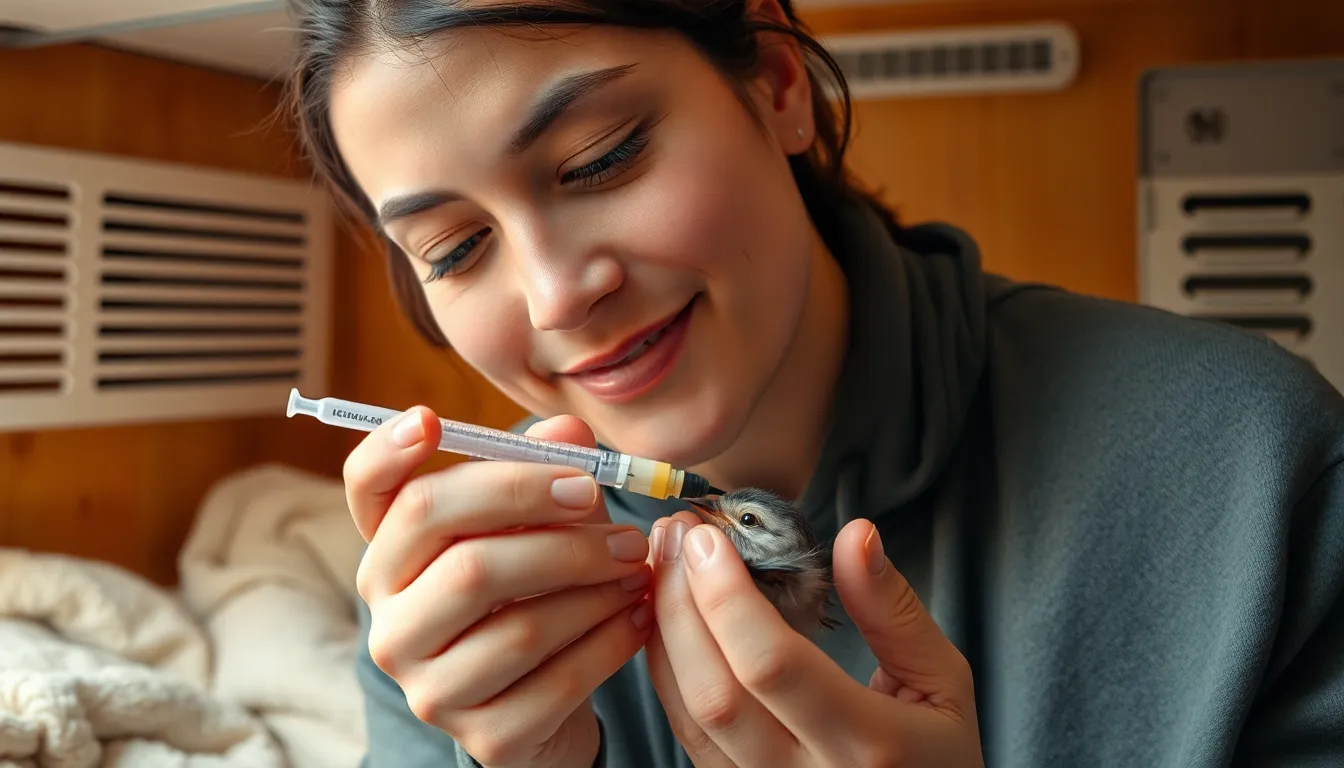
Caring for baby birds requires specialized knowledge and techniques that differ drastically from caring for adult birds or other pets. Licensed wildlife rehabilitators possess the expertise and legal authorization to provide proper care for these vulnerable creatures.
Proper Feeding Techniques and Diet Requirements
Baby birds require species-exact diets that mimic what their parents provide in the wild. Commercial hand-feeding formulas designed for wild birds offer the most appropriate nutrition, unlike bread, milk, or seeds which can cause severe digestive problems.
Feeding frequency depends on the bird’s age and species:
| Age Category | Feeding Interval | Daily Feedings |
|---|---|---|
| Hatchlings (0-5 days) | Every 15-20 minutes | 45-50 times |
| Young nestlings (6-10 days) | Every 30-45 minutes | 20-30 times |
| Older nestlings (11+ days) | Every 1-2 hours | 8-12 times |
Formula temperature must remain between 104-106°F to prevent crop burns or hypothermia. We use specialized syringes or feeding tubes to deliver food directly into the bird’s crop, avoiding the trachea which can cause aspiration pneumonia.
Songbird chicks like robins and cardinals consume insects, worms, and protein-rich foods during development. Waterfowl babies require waterfowl-exact starter crumbs mixed with appropriate vitamins and minerals. Raptor chicks demand whole prey items or specialized carnivorous formulas containing proper calcium and phosphorus ratios.
Creating a Safe Environment
Temperature regulation remains critical for baby bird survival since they cannot maintain body heat independently. We maintain ambient temperatures between 85-90°F for hatchlings, gradually decreasing to 75-80°F as feathers develop.
Housing requirements include:
- Ventilated containers with soft, non-fibrous bedding materials like paper towels or fleece
- Quiet locations away from household pets, children, and excessive noise
- Appropriate sizing that prevents injury while allowing natural movement
- Easy cleaning access to maintain sanitary conditions and prevent bacterial growth
Lighting cycles must replicate natural day and night patterns to support proper circadian rhythms. We avoid constant artificial lighting which can disrupt sleep patterns and stress responses in developing birds.
Humidity levels between 40-60% support healthy respiratory function and prevent dehydration. Substrate materials like newspaper or paper towels allow easy monitoring of droppings and prevent bacterial buildup that occurs with cloth or towel materials.
Common Mistakes to Avoid
Attempting to care for baby birds without proper permits violates federal and state wildlife protection laws. The Migratory Bird Treaty Act prohibits possession of most native bird species without exact rehabilitation licenses.
Feeding inappropriate foods causes malnutrition, digestive blockages, and developmental deformities. Bread, crackers, milk, and pet bird seed lack essential nutrients and can result in metabolic bone disease or crop stasis.
Handling errors include:
- Excessive human contact leading to imprinting and inability to survive in the wild
- Improper restraint techniques causing fractures or internal injuries
- Inadequate hygiene practices spreading diseases between birds
- Delayed veterinary intervention when injuries or illnesses require immediate treatment
Releasing birds prematurely before they develop full flight capabilities results in predation or starvation. We ensure fledglings demonstrate complete independence, proper flight patterns, and natural foraging behaviors before release consideration.
Mixing different species together creates territorial conflicts, disease transmission, and inappropriate behavioral learning. Each species requires exact care protocols that prevent cross-contamination and support natural development patterns.
When Baby Birds Should Return to the Wild
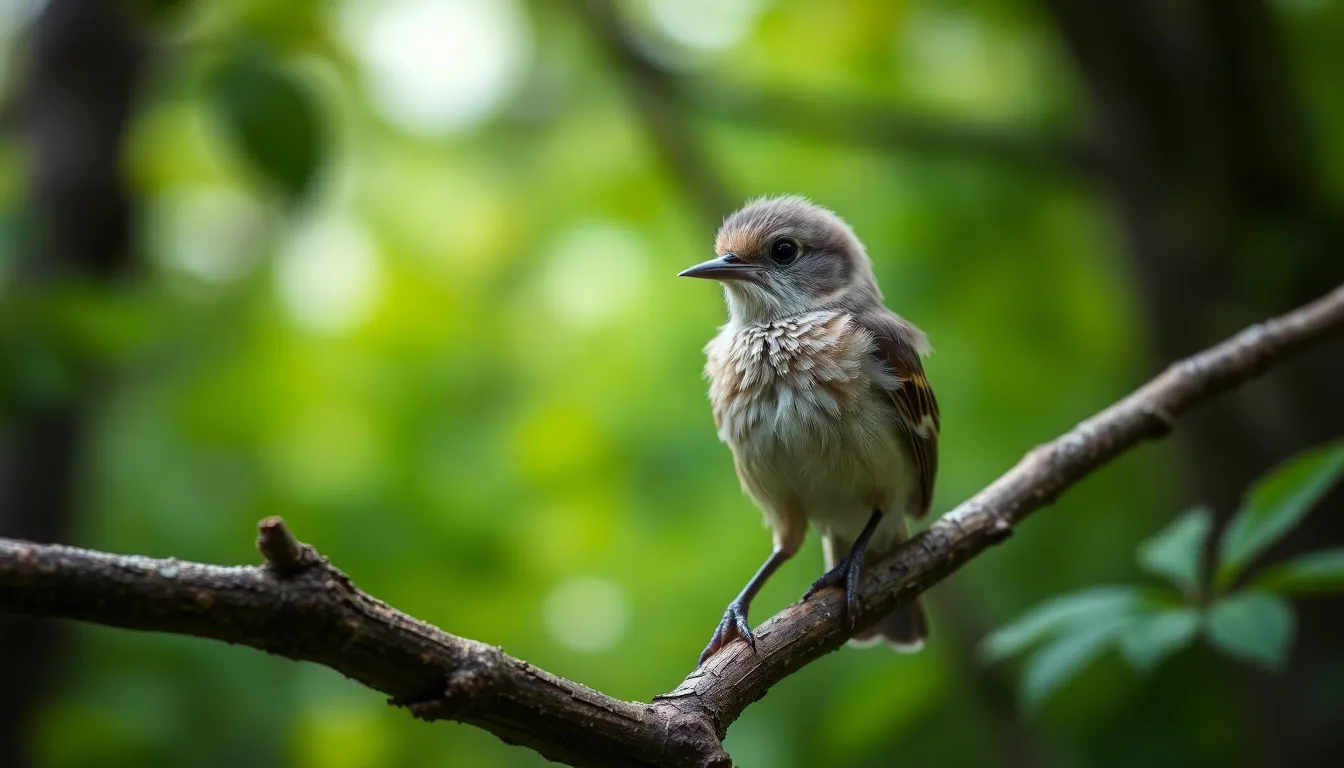
Baby birds reach return readiness when they demonstrate complete independence from parental care and possess all necessary survival skills. We assess multiple developmental markers before determining release timing for each species.
Recognizing Readiness for Release
Flight capabilities serve as the primary indicator of release readiness in most bird species. Fledglings must demonstrate sustained flight for distances exceeding 50 feet and execute controlled landings on various surfaces. Strong flight muscles allow birds to escape predators and reach food sources effectively.
Foraging independence marks another critical milestone we evaluate before release. Baby birds must locate and consume appropriate food sources without assistance for 3-5 consecutive days. Species like robins require proficiency in ground foraging while cardinals need seed cracking abilities. Waterfowl young must master diving techniques and aquatic plant identification.
Physical development completion ensures successful wild survival. We verify that tail feathers reach full length and wing feathers show no gaps or blood quills. Body weight reaches species-appropriate adult ranges with songbirds typically achieving 85-95% of adult weight. Proper thermoregulation eliminates dependence on external heat sources.
Behavioral maturity encompasses predator recognition and appropriate fear responses. Released birds demonstrate wariness around potential threats like cats, hawks, and humans. Social behaviors align with species norms including territorial awareness in songbirds and flock integration in waterfowl. Communication skills include species-exact calls for danger alerts and mate attraction.
The Importance of Natural Development
Natural development timing varies significantly among bird species and cannot be rushed without compromising survival rates. Songbird species complete development in 12-21 days from hatching while raptors require 6-12 weeks depending on their size. Premature release results in 70% mortality rates within the first week according to wildlife rehabilitation studies.
Seasonal factors influence optimal release timing regardless of individual development status. Spring releases between April and June provide abundant food sources and favorable weather conditions. Summer releases work well for early season species but become challenging during drought periods. Fall releases require careful timing before migration periods begin for relevant species.
Weather conditions directly impact release success rates across all bird species. Clear skies with temperatures between 65-75°F create ideal release conditions. Wind speeds below 15 mph prevent flight difficulties for newly independent birds. Rain delays releases by 24-48 hours as wet feathers compromise insulation and flight efficiency.
Habitat availability determines release location suitability and long-term survival prospects. We identify territories with appropriate food sources, nesting sites, and minimal human interference. Urban releases require parks or green spaces exceeding 5 acres while rural releases need diverse habitat types. Water sources within 1000 feet support hydration needs for all species.
Parental presence in release areas enhances survival rates for some species through continued learning opportunities. Adult birds provide foraging demonstrations and predator warnings that rehabilitation cannot fully replicate. But many species like most songbirds establish territories independently without parental guidance after fledging.
Human activity levels in potential release areas affect adaptation success rates significantly. High traffic zones create stress and collision risks while remote areas may lack sufficient food diversity. Moderate human presence in suburban parks often provides optimal conditions balancing safety with resource availability.
Legal Considerations and Wildlife Protection
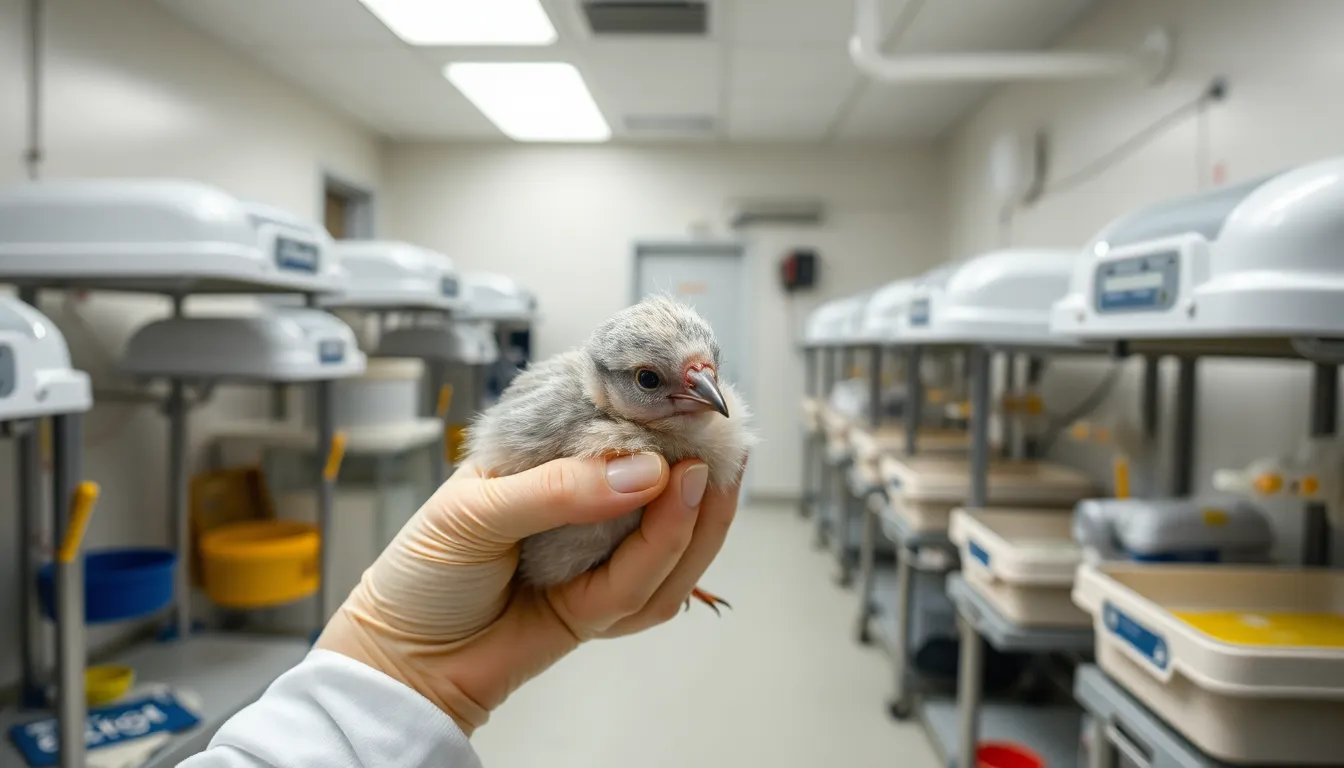
Legal frameworks protect baby birds through comprehensive federal and state regulations that govern wildlife care. Understanding these laws prevents potential legal violations while ensuring proper protection for vulnerable bird populations.
Federal and State Regulations
Federal law provides the foundation for baby bird protection through the Migratory Bird Treaty Act, which covers over 1,000 species across North America. This legislation prohibits possession, transportation, or care of protected birds without proper permits. Violations carry fines up to $15,000 and potential imprisonment for six months.
State regulations complement federal protections by establishing exact licensing requirements for wildlife rehabilitation. Each state maintains distinct permit processes that authorize individuals to care for injured or orphaned birds. California requires 100 hours of supervised training before issuing permits, while Texas mandates annual continuing education credits for license renewal.
Native bird species receive protection under both federal and state jurisdictions, creating overlapping regulatory frameworks. Game birds like waterfowl fall under additional hunting regulations administered by state wildlife agencies. Exotic species face different legal classifications, though many states prohibit their possession without specialized permits.
Possession violations occur when individuals keep baby birds without authorization, even with good intentions. Law enforcement agencies actively investigate reports of illegal wildlife possession, particularly during peak breeding seasons from April through August. Documentation requirements include detailed records of bird intake, care provided, and release outcomes for all permitted activities.
Why Professional Care Is Often Required
Licensed wildlife rehabilitators possess specialized knowledge that directly impacts survival rates for baby birds in distress. Professional facilities maintain species-exact diets that match nutritional requirements throughout different developmental stages. Songbird babies require protein levels between 16-24% during their first week, while raptor chicks need 18-20% protein content with exact amino acid profiles.
Equipment access distinguishes professional care from amateur attempts at bird rehabilitation. Licensed facilities use incubators that maintain precise temperature ranges of 85-90°F for hatchlings and 75-80°F for fledglings. Specialized feeding tools prevent aspiration pneumonia, a leading cause of death in hand-raised birds that occurs in 40% of improperly fed cases.
Medical expertise enables professionals to identify and treat conditions that appear minor but prove fatal without intervention. Parasitic infections affect 60% of orphaned birds, while bacterial infections develop in 35% of cases involving human contact. Veterinary partnerships provide access to antibiotics, anti-parasitic medications, and surgical interventions that aren’t available to unlicensed caregivers.
Release preparation protocols ensure baby birds develop natural behaviors essential for survival. Professional facilities use flight conditioning exercises that build muscle strength over 2-4 week periods. Socialization with same-species birds prevents imprinting on humans, which occurs in 25% of hand-raised birds that lack proper social development during critical periods.
Success rates demonstrate the effectiveness of professional intervention compared to amateur care attempts. Licensed rehabilitators achieve 70-85% survival rates for baby songbirds, while unlicensed efforts typically result in 15-30% survival. Waterfowl rehabilitation shows even greater disparities, with professional facilities reporting 80% success rates versus 10% for amateur attempts.
Conclusion
Understanding baby bird development and behavior helps us make informed decisions when we encounter these vulnerable creatures. We’ve learned that our natural instinct to help isn’t always what’s best for the bird’s survival and independence.
The key takeaway is observation before action. Most baby birds we find are simply following their natural developmental process and don’t need our intervention. Fledglings on the ground are often learning to fly while their parents watch nearby.
When intervention is necessary we must remember the legal requirements and importance of professional care. Licensed wildlife rehabilitators have the expertise and legal authority to provide the specialized care these birds need for successful rehabilitation and release.
By respecting wildlife regulations and trusting trained professionals we give baby birds their best chance at returning to the wild where they belong.
Frequently Asked Questions
What is considered a baby bird?
A baby bird is any young avian species that hasn’t reached full maturity or independence from parental care. They have distinct characteristics like closed eyes, minimal feathers, large heads relative to their bodies, and depend on their parents for survival. Baby birds go through three main developmental stages: hatchlings, nestlings, and fledglings.
How can I tell if a baby bird needs help?
Look for physical injuries, bleeding, visible wounds, or signs of distress like continuous crying or inability to move. Healthy baby birds are active, have proper physical development, make normal vocalizations, and show evidence of parental care. If parents haven’t returned after 2-4 hours of observation, the bird may need assistance.
What should I do if I find a baby bird on the ground?
First, determine if it’s a fledgling learning to fly (normal behavior) or truly in distress. Healthy fledglings with parents nearby should be left alone. If intervention is needed, gently place the bird in a ventilated box lined with soft cloth, keep it warm and quiet, and contact a licensed wildlife rehabilitator immediately.
Is it legal to care for baby birds at home?
No, caring for most baby birds without proper permits is illegal under the Migratory Bird Treaty Act and state regulations. Only licensed wildlife rehabilitators have the legal authority and specialized training to care for protected bird species. Attempting home care can result in legal penalties and harm to the bird.
Why is professional care better than home care for baby birds?
Licensed wildlife rehabilitators have specialized knowledge, proper equipment, and experience that significantly improve survival rates. They understand species-specific feeding requirements, possess medical expertise, and follow proper release protocols. Professional care achieves much higher survival rates compared to amateur attempts, ensuring birds develop natural behaviors essential for survival.
When do baby birds leave the nest?
The timing varies by species and developmental stage. Songbird nestlings typically remain in nests for 9-16 days before becoming fledglings. Waterfowl like ducklings leave nests within 24-48 hours as they’re precocial (born ready to walk and feed). Birds of prey may stay in nests for several weeks before fledging.
How can I find a licensed wildlife rehabilitator?
Contact your state wildlife agency, search national wildlife rehabilitation directories, or call local veterinary clinics for referrals. Many states maintain lists of licensed rehabilitators on their wildlife department websites. When contacting rehabilitators, document the bird’s location, condition, and circumstances to help them provide appropriate guidance.
What are the three stages of baby bird development?
The three stages are: hatchlings (entirely dependent, eyes closed, minimal feathers), nestlings (rapid growth phase, developing mobility and calls while remaining in nest), and fledglings (have left the nest but still rely on parents while learning survival skills like foraging and predator avoidance).

